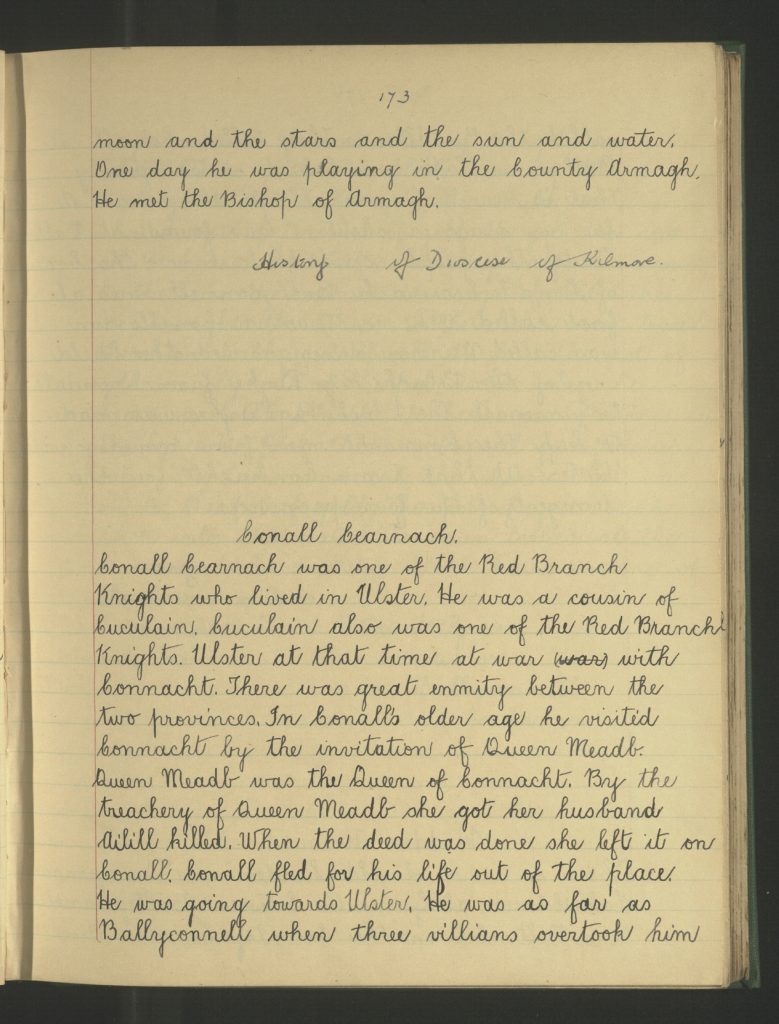Tithe Applotments
No Ruddens are listed on the Tithe Applotment for Ballyconnell.
Griffith’s Valuation
No Ruddens were found on the Griffith’s Valuation records found for Ballyconnell, Cavan
1901 Census
Residents of house 18 in Ballyconnell (Ballyconnell, Cavan)
| Surname | Forename | Age | Sex | Relation to head | Religion |
|---|---|---|---|---|---|
| Brady | Nicholas | 71 | Male | Head of Family | Roman Chatolic |
| Ruden | Rose Ann | 33 | Female | Niece | Roman Cahelic |
| Rudden | Nicholas | 29 | Male | Nephew | Roman Cathelic |
| Donohue | Bridget | 50 | Female | Servant | Roman Cathelic |
1911 Census
Residents of house 46 in Ballyconnell Town (Ballyconnell, Cavan)
| Surname | Forename | Age | Sex | Relation to head | Religion |
|---|---|---|---|---|---|
| Toomey | James | 60 | Male | Head of Family | Roman C |
| Toomey | Eliza | 50 | Female | Sister | Roman C |
| Rudden | Bernard | 28 | Male | Assistant | Roman C |
| Gearty | Katie | 24 | Female | Assistant | Roman C |
| Gearty | Maggie | 16 | Female | Assistant | Roman C |
| Reilly | Phill | 18 | Male | Assistant | Roman C |
| Donahoe | William | 18 | Male | Assistant | Roman C |
| McKiernan | Joe | 29 | Male | Servant | Roman C |
| McKenna | Bessie | 18 | Female | Servant | Roman C |
| Drummond | Michael | – | Male | Boarder | Roman C |
| Drummond | Michael | 64 | Male | Boarder | Roman Catholic |
| Drummond | Nora Mary | 53 | Female | Boarder | Roman Catholic |
Notes: The Schools Collection
The following excerpt has been taken from the Schools Collection which is essentially a gathering of local folklore that Irish school children were asked to compile during the 1930’s. The following describes the legend of how Ballyconnell got its name.


Transcribed from the above story.
Conall Cearnach was one of the Red Branch Knights who lived in Ulster. He was a cousin of Cuculain, Cuculain also was one of the Red Branch Knights. Ulster at that time at war with Connacht. There was great enmity between the two provinces. In Conall’s older age he visited Connacht by the invitation of Queen Meadb. Queen Meadb was the Queen of Connacht. By the treachery of Queen Meadb she got her husband Ailill killed. When the deed was done she left it on Conall. Conall fled for his life out of the place. He was going towards Ulster. He was as a far as Ballyconnell when three villians overtook him called the Ruadhcoins. They killed Conall at Ballyconnell. He was buried at Ballyheady.
That is how Ballyconnell got it’s name. A few years ago a skeleton was found at Ballyheady the people said that it was the bones of Conall Cernach. Ballyconnell was at first called Ath na Mianna. Conalls son was called Miamn. He engineered the building of thr Black Pig Dyke was made to help the Connacht men from coming into Ulster. At that time Connacht was the strongest of the four provinces.
Written by Peter McGovern, Ballyconnell.
Source: Munlough · The Schools’ Collection | dúchas.ie (duchas.ie)

Leave a Reply